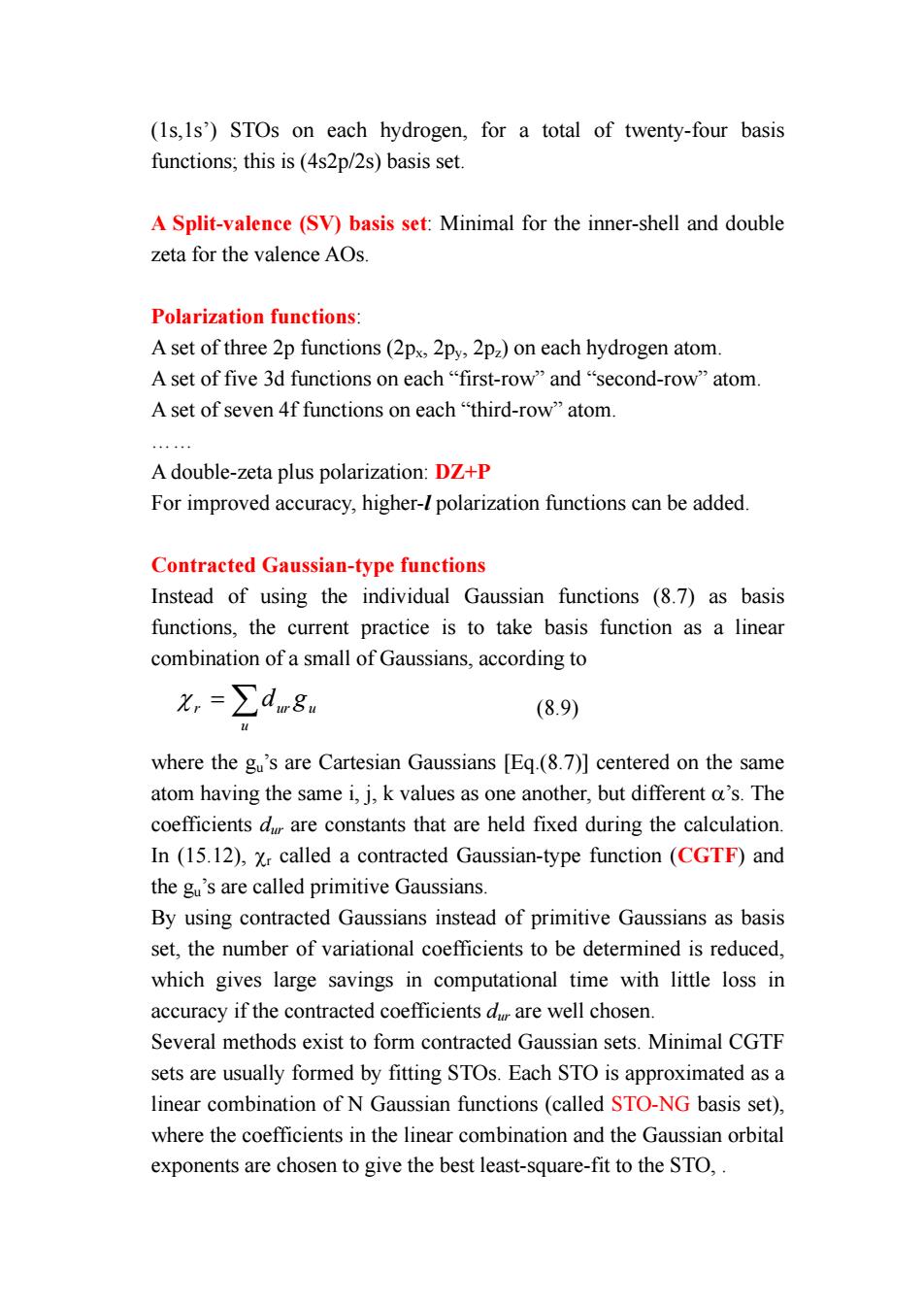正在加载图片...

(1s,Is')STOs on each hydrogen,for a total of twenty-four basis functions;this is(4s2p/2s)basis set A Split-valence (SV)basis set:Minimal for the inner-shell and double zeta for the valence AOs Polarization functions A set of three 2p functions(2px,2py,2pz)on each hydrogen atom A set of five3 d functions on each“first--row'and“second-row”atom. A set of seven 4f functions on each"third-row"atom. A double-zeta plus polarization:DZ+P For improved accuracy,higher-I polarization functions can be added. Contracted Gaussian-type functions Instead of using the individual Gaussian functions (8.7)as basis functions,the current practice is to take basis function as a linear combination of a small of Gaussians,according to X,=∑dn8 (8.9) where the gu's are Cartesian Gaussians [Eq.(8.7)]centered on the same atom having the same i,j,k values as one another,but different a's.The coefficients dr are constants that are held fixed during the calculation In (15.12),Xr called a contracted Gaussian-type function (CGTF)and the gu's are called primitive Gaussians. By using contracted Gaussians instead of primitive Gaussians as basis set,the number of variational coefficients to be determined is reduced, which gives large savings in computational time with little loss in accuracy if the contracted coefficients d are well chosen. Several methods exist to form contracted Gaussian sets.Minimal CGTF sets are usually formed by fitting STOs.Each STO is approximated as a linear combination of N Gaussian functions(called STO-NG basis set). where the coefficients in the linear combination and the Gaussian orbital exponents are chosen to give the best least-square-fit to the STO, (1s,1s’) STOs on each hydrogen, for a total of twenty-four basis functions; this is (4s2p/2s) basis set. A Split-valence (SV) basis set: Minimal for the inner-shell and double zeta for the valence AOs. Polarization functions: A set of three 2p functions (2px, 2py, 2pz) on each hydrogen atom. A set of five 3d functions on each “first-row” and “second-row” atom. A set of seven 4f functions on each “third-row” atom. …… A double-zeta plus polarization: DZ+P For improved accuracy, higher-l polarization functions can be added. Contracted Gaussian-type functions Instead of using the individual Gaussian functions (8.7) as basis functions, the current practice is to take basis function as a linear combination of a small of Gaussians, according to u u χ r = ∑dur g (8.9) where the gu’s are Cartesian Gaussians [Eq.(8.7)] centered on the same atom having the same i, j, k values as one another, but different α’s. The coefficients dur are constants that are held fixed during the calculation. In (15.12), χr called a contracted Gaussian-type function (CGTF) and the gu’s are called primitive Gaussians. By using contracted Gaussians instead of primitive Gaussians as basis set, the number of variational coefficients to be determined is reduced, which gives large savings in computational time with little loss in accuracy if the contracted coefficients dur are well chosen. Several methods exist to form contracted Gaussian sets. Minimal CGTF sets are usually formed by fitting STOs. Each STO is approximated as a linear combination of N Gaussian functions (called STO-NG basis set), where the coefficients in the linear combination and the Gaussian orbital exponents are chosen to give the best least-square-fit to the STO,